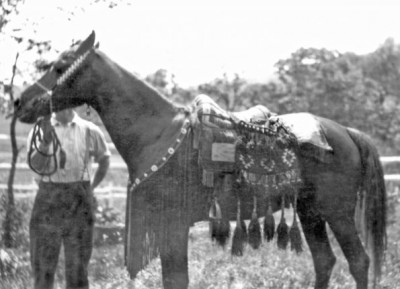Barely Surviving Lines: Saqlawi al-‘Abd line of *Wadduda through Serije
The more I browse through the Al Khamsa Online Roster, the more I realize the importance of the desert-bred mare *Wadduda. She was a chestnut Saqlawiyat al-‘Abd, and was the war-mare of the Bedouin chieftain Hakim Ibn Mhayd of the Fad’aan tribe, before she was imported to the USA by Homer Davenport in 1906. There is even a series of children books about “Wadduda of the Desert”.

*Wadduda has left a lot of asil offspring in the tail female, mostly through her descendent Sahanad (Abu Hanad x Sahabet by Tanatra), a mare that started a dynasty of her own. Sahanad has an active preservation group of her own, and there are around 150 horses tracing to her today!

However, there are other lines of asil Arabians to *Wadduda, too. These run the risk of being overlooked in part because of the success of the Sahanad preservation effort, and in part because they do not belong to any of todays breeding groups/silos within US Arabian horse breeding. Jeanne Craver recently mentioned on this blog that an attempt was currently being made to find a preservation home for a 21 year old mare from one of these lines. The mare is Jadiba (Dib x Jabinta by Jadib).
Jadiba’s sire Dib, her maternal grandsire Jadib, and her maternal great-grandsire Subani are all of Doyle breeding, so she is of overwhelmingly Crabbet bloodlines. Her great-grand-dam Malakah (Arafat x Zoe by Ameer Ali), bred by Fred Glass of Oklahoma, is a double grand-daughter of Serije (Letan x Sedjur, pictured below as a foal) and blends together various old American lines tracing to Arabian horses imported from the desert to the UK and the USA in the late XIXth and early XXth century by the likes of Major R. Upton, Homer Davenport, and the Ottoman Hamidie Society.

Jadiba exemplifies “Combined Source” breeding at its best. In the USA, “Combined Source” refers to the established practice of breeding together Arabian horses from different importations from the Arabian desert (the Blunt’s importaions, the Hamidie Society importation, Major Upton’s importation, Homer Danveport’s importation, W.R. Heart’s importation, smaller ones, etc). “Combined Source” horses were at the core of American Arabian horse breeding in the first part of the twentieth century. Jadiba is essentially of Crabbet plus Davenport combined source bloodlines, which is the most popular “Combined Source” combinatation.
Historically, some of the best horses in the USA were of “Combined Source” bloodlines. Of course, all these “sources” ultimately trace to a unique “source”, the Arabian desert, and they are all asil Arabians.
Jadiba is also a time capsule. She belongs to a very small group of asil Arabians sometimes referred to as “Volume Five” horses. These are the descendents of the horses that were registered in the first five volumes of the Arab Horse Association Studbook. They typically consist of the descendents of the earlier importations of Arabian horses to the USA. What makes these earlier importations significant is that they were made at a time when the old Bedouin way of life was still prevailing and the Arabian horse was still an instrument of inter-tribal warfare. They are the ‘real thing’.
Good luck to Jadiba’s lucky owner in trying to save this precious line from extinction. Looking forward to hearing news of a foal next year..
HI
In South Africa we have a line to Wadudda through the mare Galraffa. They are wonderful endurance horses.
Thank you for this informative submission and the accompanying photos!
As a young mare, Jadiba, proved to be outstanding when in training for endurance riding. An intelligent, strong, sound and swift mare, she gave her all to our partnership with graceful ease. Jadiba enjoyed our many trail rides, negotiating various types of terrain and covering ground as swiftly as possible at a pace she could maintain for ever increasing distances of significance.
She did not suffer fools, but was an exceptionally willing and trustworthy partner. I would have trusted her with my life.
Jadiba was an easy breeder as a young mare, having foals without any problems. She cooperated willingly in my imprinting her two daughters by Ibn Tirf shortly after their births – I very gently handled every part of each foal’s body, and tapped lightly on the tiny hooves to imprint them for the farrier they’d meet in the future.
Jadiba weaned each foal naturally by gradually allowing each one to suckle less and less over time when she judged the time was right. As long as I had her at my farm, Jadiba lived in a large pasture with areas of shady apple trees, evergreens and blueberry bushes. The pasture was shared with the two geldings I rode in endurance and other trail rides, plus dressage and some eventing. Jadiba’s daughters joined this herd after they’d come into the world. This pasture contained a roomy shed for shelter, with a deep bedding of wood shavings.
These are fond memories of the best mare I ever cared for and worked with, in a lifetime of having horses at that point. I also wanted to share memories of the births of her two lovely daughters (whom many mistook as twins, although the older one was foaled in May 1993 and the younger in June 1994).